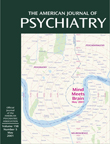Domestic Abuse and Religion
To the Editor: The Clinical Case Conference of Nada L. Stotland, M.D., M.P.H. (1), is a superb example of clinical application with compassion. It also highlights the need for collaboration between psychiatrists and clergy in regard to domestic violence. Many people trying to make sense out of difficult experiences seek support in times of crisis from religious faith and community, so it is not surprising that clergy are often the first professionals sought for help by abused women. A national survey of 1,000 battered wives found that one in three of them received assistance from pastors, and one in 10 of their battering husbands were counseled by clergy (2). Unfortunately, too often clergy are perceived to be ineffective in their efforts on behalf of battered women by groups that help victims (3). It is hoped that greater numbers of female clergy and psychiatrists will expand awareness of the problem of domestic violence and develop cooperation in dealing with it.
A recent national survey of reform, conservative, and orthodox rabbis (4) provided evidence that knowledge and attitudes of clergy about spouse abuse may have begun to improve. In the study, 80% of the rabbis felt that physical injury of a wife should be criminally prosecuted. They also stated a general willingness to intervene immediately on behalf of abused wives to stop maltreatment. About one-half of the rabbis had preached a sermon against domestic violence in the preceding year. Research shows that religious involvement can be a factor in reducing the risk of spousal abuse. In a national survey of 4,662 Catholics and Protestants (5), higher levels of church attendance were predictive of lower levels of reported cases of domestic violence. The exception to this pattern was Protestants, who held strong beliefs about the inerrancy of the Bible and religious authority.
Many clergy feel inadequately trained in the area of spousal abuse and express a desire for additional training (4). Psychiatrists working with clergy are particularly important as a preventive measure, since nearly all clergy provide premarital counseling before performing weddings, and they perform 75% of all weddings in the United States (6). Specifically, assistance is needed in developing tools for use in premarital counseling to screen couples at risk for domestic violence, as is guidance about how to help such couples understand the need for further counseling and how to make an effective referral. Greater cooperation between psychiatrists and clergy offers new hope for addressing domestic violence more effectively.
1. Stotland NL: Tug-of-war: domestic abuse and the misuse of religion. Am J Psychiatry 2000: 157:696–702Google Scholar
2. Bowker LH: Religious victims and their religious leaders, in Abuse and Religion. Edited by Horton AL, Williamson JA. Lexington, Mass, Heath, 1988, pp 229–234Google Scholar
3. Gordon JS: Community services for abused women. J Fam Violence 1996; 11:315–329Crossref, Google Scholar
4. Cwik MS: Peace at home? J Psychology and Judaism 1997; 21:7–67Google Scholar
5. Ellison CG, Bartkowski JP, Anderson KL: Are there religious variations in domestic violence? J Fam Issues 1999; 20:87–113Google Scholar
6. Jones EF, Stahmann RF: Clergy beliefs, preparation, and practice in premarital counseling. J Pastoral Care 1994; 48:181–186Crossref, Google Scholar



